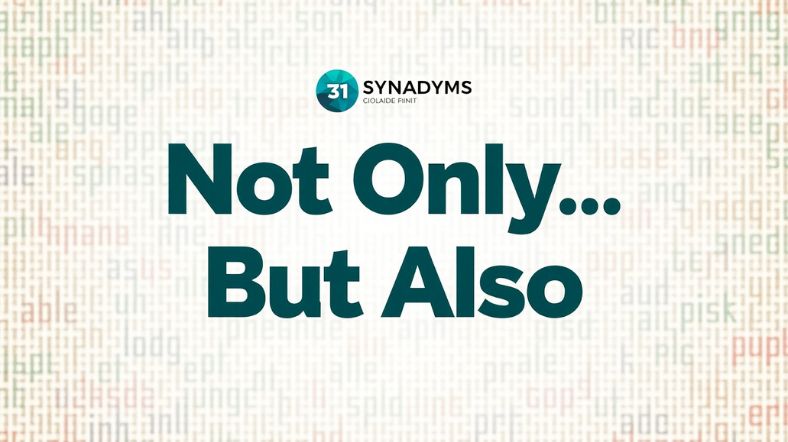In the dynamic world of communication, it’s important to express yourself with variety and clarity. One phrase that often appears in writing and conversation is “not only… but also.” While this phrase is highly effective for emphasizing two ideas or concepts, it can become repetitive when used frequently.
Thankfully, there are many other ways to convey a similar meaning while keeping your speech or writing fresh and engaging.
Below, we’ve compiled 31 fantastic alternatives that can enrich your language, whether you’re writing an email, delivering a speech, or engaging in casual conversation.
These phrases can help add flavor, maintain flow, and appeal to your audience, making your message all the more impactful.
As Well As
- Meaning and Context: This phrase is often used to connect ideas, much like “not only… but also,” but it can sound less formal and more inclusive.
- Example: “I enjoy hiking as well as swimming on the weekends.”
- Impact: This is a versatile phrase that fits both formal and casual contexts, ideal for when you want to link related ideas smoothly.
In Addition To
- Meaning and Context: “In addition to” serves the same function as “not only… but also,” but it has a more formal tone, often found in professional writing.
- Example: “The company offers flexible hours in addition to competitive pay.”
- Impact: This phrase brings a sense of completeness to your communication, signaling that more information or benefits follow.
Furthermore
- Meaning and Context: Common in formal contexts, this phrase emphasizes the continuation or enhancement of a previous statement.
- Example: “She is a talented artist. Furthermore, she is an accomplished musician.”
- Impact: It boosts your argument by showing that the next point is equally important, making your statement stronger.
Moreover
- Meaning and Context: Similar to “furthermore,” “moreover” is used to add weight to an idea. It’s slightly more emphatic and often used in academic or professional writing.
- Example: “Not only did she complete the project early, moreover, she exceeded expectations.”
- Impact: This phrase elevates your point, highlighting the significance of the added information.
Along With
- Meaning and Context: “Along with” works well in both casual and professional settings. It suggests inclusion and connection between two things or actions.
- Example: “She brought her guitar along with her songbook to the jam session.”
- Impact: It adds a natural flow to your sentences, making the connection between ideas feel seamless.
Not To Mention
- Meaning and Context: This phrase introduces an additional point, often one that’s particularly noteworthy or important.
- Example: “He’s an amazing chef, not to mention his ability to create unique recipes.”
- Impact: It draws attention to an important detail without sounding too formal or rigid, perfect for conversational contexts.
Besides
- Meaning and Context: “Besides” is used to introduce something that complements or strengthens the previous point. It’s great for casual conversations.
- Example: “I love reading books, besides spending time with my family.”
- Impact: This informal phrase invites the listener to consider additional aspects, making your conversation feel warmer and more personal.
Also
- Meaning and Context: “Also” is one of the simplest alternatives and can be used in nearly any context, from formal to casual.
- Example: “She is studying law; also, she’s taking advanced literature courses.”
- Impact: It helps maintain a natural flow, adding information without being overly elaborate.
On Top Of
- Meaning and Context: This phrase suggests that one thing is added to another, often with a sense of abundance or excess.
- Example: “Not only did he handle the meeting, on top of managing a new project.”
- Impact: This phrase has a bit of energy to it, making your message feel more dynamic and full.
Additionally
- Meaning and Context: “Additionally” is a straightforward way to add more information, particularly useful in professional or academic settings.
- Example: “The new policy reduces paperwork, additionally improving overall workflow.”
- Impact: This phrase offers clarity and focus, enhancing the professionalism of your communication.
Together With
- Meaning and Context: “Together with” is a more casual and friendly alternative, suitable for both spoken and written contexts.
- Example: “I’m bringing my friend together with her guitar for the band rehearsal.”
- Impact: It creates a feeling of collaboration and unity, making the connection between ideas feel more inclusive.
What’s More
- Meaning and Context: Used in informal settings, this phrase brings extra weight to your following point, often in a casual or conversational tone.
- Example: “I completed the project on time; what’s more, I saved the company money.”
- Impact: It introduces an exciting or important point, adding energy to your speech or writing.
Likewise
- Meaning and Context: “Likewise” is used to draw a parallel between two similar ideas or situations. It’s concise and professional.
- Example: “She excelled in mathematics. Likewise, her work in physics was impressive.”
- Impact: This phrase emphasizes equality and balance between ideas, making your message feel well-rounded.
Coupled With
- Meaning and Context: “Coupled with” works well when you want to show that two things are combined or have a shared impact.
- Example: “The stormy weather, coupled with strong winds, caused power outages.”
- Impact: It gives the impression that one point naturally flows from the other, providing a smooth and logical progression.
As A Bonus
- Meaning and Context: This phrase is ideal when you want to add an unexpected or extra advantage to something.
- Example: “She completed the assignment early and, as a bonus, she offered to help others.”
- Impact: It brings a lighthearted touch, implying that something extra has been added that enhances the situation.
Not Only But Also Sentence Examples
- Meaning and Context: This phrase allows you to show two connected ideas, often highlighting the importance of both. It works in both formal and informal contexts.
- Example: “She not only completed the project ahead of schedule but also exceeded all expectations.”
- Impact: Using this structure helps you highlight the significance of two ideas at once, making your point clear and impactful.
Synonym for Not Only
- Meaning and Context: When you’re looking for alternatives to “not only,” phrases like “in addition to,” “as well as,” or “besides” can fit in your sentence structure.
- Example: “He is skilled in addition to being incredibly hardworking.”
- Impact: This variety in phrasing allows you to keep your language fresh, while still conveying the same concept effectively.
Not Only Synonyms
- Meaning and Context: There are many ways to express “not only” without sounding repetitive, such as “along with,” “besides,” or “together with.”
- Example: “She enjoys painting, along with playing the piano.”
- Impact: Switching to synonyms can help avoid monotony and strengthen your argument by diversifying the structure.
Other Ways to Say Not Only
- Meaning and Context: Depending on your tone, “moreover,” “furthermore,” or “what’s more” can serve as great alternatives to “not only.”
- Example: “The company is expanding internationally; moreover, it plans to launch new products.”
- Impact: These alternatives are especially useful in formal writing, where you want to present ideas in a structured and emphatic way.
Synonym for But Also
- Meaning and Context: To replace “but also,” consider using “as well as,” “along with,” or “not to mention.”
- Example: “She’s not just a talented designer, as well as an inspiring leader.”
- Impact: Choosing the right synonym for “but also” helps create a smoother sentence, especially when paired with alternatives for “not only.”
Not Only This Synonyms
- Meaning and Context: When emphasizing an additional point, phrases like “besides this,” “in addition to this,” or “on top of this” work well.
- Example: “She’s not only a top student, besides this, she’s actively involved in community work.”
- Impact: This helps add a layer of richness to your communication, reinforcing that there’s more to the story.
50 Sentences of Not Only … But Also
- Meaning and Context: Examples like this can serve as a great reference to help expand your usage of the phrase. It allows you to practice how the structure flows in different contexts.
- Example: “He is not only a great cook, but also an expert in food photography.”
- Impact: It gives you a chance to develop familiarity with how and when to apply this structure in various sentences, improving your language skills.
Not Only But Also Examples with Answers
- Meaning and Context: This type of exercise can help you understand how “not only … but also” fits into a sentence, and how alternatives work in the same context.
- Example: “She not only solved the problem but also improved the overall process.”
- Impact: This approach is excellent for learners or anyone looking to reinforce their language skills through practice.
Not Only But Also Synonym
- Meaning and Context: When searching for a synonym, “besides” and “as well as” are versatile substitutes that maintain the idea of adding another concept.
- Example: “The company offers competitive wages, besides great health benefits.”
- Impact: Using synonyms for “not only … but also” can enhance the clarity of your sentence, especially in less formal settings.
Not Only But Also Inversion
- Meaning and Context: Inversions are a fun way to play with sentence structure, often creating a more dramatic or formal tone.
- Example: “Not only did she complete the task, but she also did it with style.”
- Impact: Inversion adds emphasis, making the sentence feel more impactful and intentional, great for speeches or written content that requires a strong focus.
Not Only But Also Sentences Exercises
- Meaning and Context: These exercises help strengthen your grasp of the phrase, encouraging creativity and flexibility in its usage.
- Example: “Not only did they arrive early, but they also stayed late to help.”
- Impact: These exercises allow you to refine your language skills, making you more confident in using complex sentence structures.
10 Sentences on Not Only … But Also
- Meaning and Context: Practicing ten different sentences that use “not only … but also” helps reinforce its various uses across different contexts.
- Example: “She not only taught the class, but also mentored several students after school.”
- Impact: This exercise enables you to explore different sentence constructions, enhancing your fluency and versatility in communication.
Not Only But Also Rules
- Meaning and Context: Understanding the grammatical rules behind “not only … but also” can help you avoid common mistakes, such as subject-verb agreement.
- Example: “Not only are they providing scholarships, but they’re also offering internships.”
- Impact: Knowing the rules helps ensure that your sentence structure is grammatically correct while still expressing complex ideas effectively.
Not Only But Also Sentence
- Meaning and Context: A straightforward sentence that follows the “not only … but also” structure can be used to connect two equally important ideas.
- Example: “The manager is not only skilled in project management, but also excels in team leadership.”
- Impact: This simple yet powerful construction allows you to highlight the dual importance of two connected ideas in your communication.
Not Only But Also Examples
Meaning and Context: Using “not only … but also” allows you to emphasize two points, showing their equal significance. You can apply this in various contexts to link complementary ideas.
- Example: “He is not only a gifted writer but also an incredible storyteller.”
- Impact: This example reinforces the power of combining two related concepts, keeping your message engaging and balanced.
Conclusion
Mastering different ways to say “not only… but also” will undoubtedly make your communication more versatile, engaging, and impactful.
Whether you’re writing a formal report, speaking in a meeting, or simply chatting with friends, these alternatives allow you to keep your language fresh and captivating.
Experiment with these phrases in your next conversation or piece of writing, and you’ll see how easily you can emphasize and connect ideas. After all, effective communication isn’t just about what you say, but how you say it!

Mark Tony is a grammar expert with 5 years of experience, specializing in teaching English grammar, enhancing writing, reading, and speaking skills for diverse learners.









